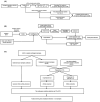Preservation of cfRNA in cytological supernatants for cfDNA & cfRNA double detection in non-small cell lung cancer patients
- PMID: 39233657
- PMCID: PMC11375324
- DOI: 10.1002/cam4.70197
Preservation of cfRNA in cytological supernatants for cfDNA & cfRNA double detection in non-small cell lung cancer patients
Abstract
Backgroud: Supernatants from various cytological samples, including body cavity effusion, sputum, bronchoalveolar lavage fluid (BALF), and needle aspiration, have been validated for detecting genetic alterations using cell-free DNA (cfDNA) in patients with non-small cell lung cancer (NSCLC). However, the sensitivity of fusion variations detection remains challenging. The protection of cell-free RNA (cfRNA) is critical for resolving the issue.
Methods: A protective solution (PS) was applied for preserving cfRNA in cytological supernatant (CS), and the quality of protected cfRNA was assessed by cycle threshold (CT) values from reverse transcription quantitative polymerase chain reaction (RT-qPCR). Furthermore, we collected an additional set of malignant cytological and matched tumor samples from 84 NSCLC patients, cfDNA & cfRNA extraction and double detection for driver gene mutations was validated using the multi-gene mutations detection by RT-qPCR.
Results: Under the optimal protection system, 91.0% (101/111) of cfRNA were protected effectively. Among the 84 NSCLC patient samples, seven cytological samples failed the tests. In comparison with tumor samples, the overall sensitivity and specificity of detecting driver genes of supernatant cfDNA and cfRNA were 93.8% (74/77) and 100% (77/77), respectively. Notably, when focusing exclusively on patients with fusion gene changes, both sensitivity and specificity reached 100% (11/11) for EML4-ALK, ROS1, RET fusions, and MET ex14 skipping.
Conclusion: These findings suggest that cfDNA & cfRNA extraction and double detection strategy recommended in this study improve the accuracy of driver genes mutations test, especially for RNA-based assay.
Keywords: NSCLC; cell‐free RNA; driver gene; fusion; liquid biopsy.
© 2024 The Author(s). Cancer Medicine published by John Wiley & Sons Ltd.
Figures



Similar articles
-
Highly sensitive fusion detection using plasma cell-free RNA in non-small-cell lung cancers.Cancer Sci. 2021 Oct;112(10):4393-4403. doi: 10.1111/cas.15084. Epub 2021 Aug 18. Cancer Sci. 2021. PMID: 34310819 Free PMC article.
-
Multigene PCR using both cfDNA and cfRNA in the supernatant of pleural effusion achieves accurate and rapid detection of mutations and fusions of driver genes in patients with advanced NSCLC.Cancer Med. 2021 Apr;10(7):2286-2292. doi: 10.1002/cam4.3769. Epub 2021 Mar 3. Cancer Med. 2021. PMID: 33656807 Free PMC article.
-
Integrating the Idylla™ System Alongside a Real-Time Polymerase Chain Reaction and Next-Generation Sequencing for Investigating Gene Fusions in Pleural Effusions from Non-Small-Cell Lung Cancer Patients: A Pilot Study.Int J Mol Sci. 2024 Jul 11;25(14):7594. doi: 10.3390/ijms25147594. Int J Mol Sci. 2024. PMID: 39062837 Free PMC article.
-
Circulating cell-free nucleic acids and platelets as a liquid biopsy in the provision of personalized therapy for lung cancer patients.Lung Cancer. 2017 May;107:100-107. doi: 10.1016/j.lungcan.2016.04.026. Epub 2016 May 4. Lung Cancer. 2017. PMID: 27180141 Review.
-
Plasma Cell-Free DNA Genotyping: From an Emerging Concept to a Standard-of-Care Tool in Metastatic Non-Small Cell Lung Cancer.Oncologist. 2021 Oct;26(10):e1812-e1821. doi: 10.1002/onco.13889. Epub 2021 Jul 26. Oncologist. 2021. PMID: 34216176 Free PMC article. Review.
Cited by
-
The Potential of cfDNA as Biomarker: Opportunities and Challenges for Neurodegenerative Diseases.J Mol Neurosci. 2025 Mar 13;75(1):34. doi: 10.1007/s12031-025-02317-8. J Mol Neurosci. 2025. PMID: 40080233 Free PMC article. Review.
References
-
- Bray F, Ferlay J, Soerjomataram I, Siegel RL, Torre LA, Jemal A. Global cancer statistics 2018: GLOBOCAN estimates of incidence and mortality worldwide for 36 cancers in 185 countries. CA Cancer J Clin. 2018;68(6):394‐424. - PubMed
-
- Rikova K, Guo A, Zeng Q, et al. Global survey of phosphotyrosine signaling identifies oncogenic kinases in lung cancer. Cell. 2007;131(6):1190‐1203. - PubMed
-
- Li YS, Jiang BY, Yang JJ, et al. Unique genetic profiles from cerebrospinal fluid cell‐free DNA in leptomeningeal metastases of EGFR‐mutant non‐small‐cell lung cancer: a new medium of liquid biopsy. Ann Oncol. 2018;29(4):945‐952. - PubMed
-
- Wang Z, Zhang L, Li L, et al. Sputum cell‐free DNA: valued surrogate sample for detection of EGFR mutation in patients with advanced lung adenocarcinoma. J Mol Diagn. 2020;22(7):934‐942. - PubMed
MeSH terms
Substances
Grants and funding
LinkOut - more resources
Full Text Sources
Medical
Miscellaneous

